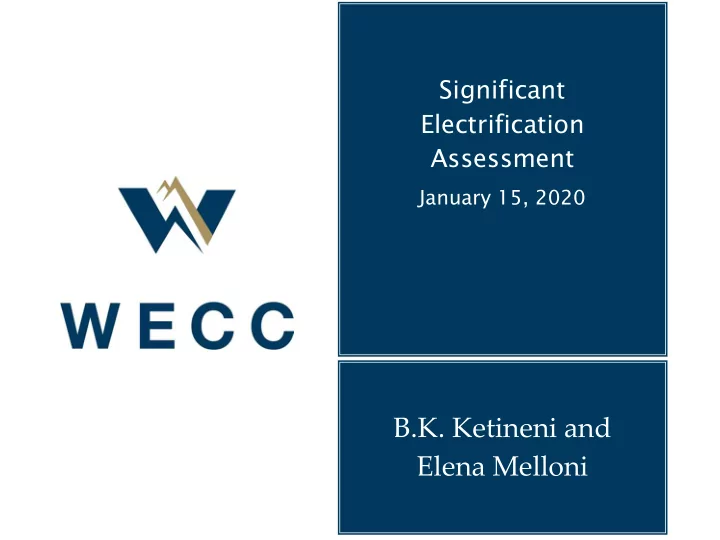

Significant Electrification Assessment January 15, 2020 B.K. Ketineni and Elena Melloni
Purpose of the study To analyze potential risks to the Western Interconnection’s reliability as electric load in the West transforms and grows through 2028. 2
Assumptions ▪ 2028 ADS PCM Phase 2 V2.0 • CAISO 50% RPS resources ▪ No additional resources were added ▪ Dispatchable load is modeled as behind-the-meter hourly generators (DER-EV) 3
Assumptions NREL provided the electrification forecast data by state in the U.S. Below is a sample of load data: Hour Area 1 2028 Static Load Area 1 2028 Flexible Load Area 1 2028 Total (MW) (MW) Load (MW) 1 11052.57 88.11 11140.68 2 10835.82 78.96 10914.78 3 10758.95 61.69 10820.64 4 … There was no electrification forecast data for provinces in Canada, so it was assumed that British Columbia had the same load growth rate as Washington state and Alberta had the same rate as Montana. 4
Electrification Forecast Slow Moderate Rapid Technology Technology Technology Advancement Advancement Advancement Reference Reference Reference Reference Customer Adoption, Slow Adoption, Adoption, Rapid Adoption Technology Moderate Technology Advancement Technology Advancement Advancement Medium Medium Medium Medium Customer Adoption, Slow Adoption, Adoption, Rapid Adoption Technology Moderate Technology Advancement Technology Advancement Advancement High Customer High Adoption, High Adoption, High Adoption, Adoption Slow Technology Moderate Rapid Advancement Technology Technology Advancement Advancement 5
Electrification Forecast ▪ System energy increased by 20%, when compared to the original ADS PCM case. ▪ System peak increased by 8%, when compared to the original ADS PCM case. Total System Energy (GWh) Total System Peak (MW) 1200000 27500 27000 1000000 26500 Peak Energy (MW) 800000 Energy (GWh) 26000 600000 25500 25000 400000 24500 200000 24000 0 23500 High Slow Scenario ADS Ph2 v2.2 High Slow Scenario ADS Ph2 v2.2 Scenarios Scenarios 6
Resource Adequacy Results : Unserved Energy Total Unserved Energy (GWh) 400 350 Unserved Energy (GWh) 300 250 200 150 100 50 0 Sensitivity Cases 7
Unserved Energy Annual Generation by Category (GWh) 2028 HighSlow-With 0$ DER-EV 2028 HighSlow-With 200$ DER-EV Conventional Hydro Energy Storage Steam - Coal Steam - Other Nuclear Generation Portfolio Combined Cycle Combustion Turbine IC Other DG/DR/EE Biomass RPS Geothermal Small Hydro RPS Solar Wind 0 100,000 200,000 300,000 400,000 Annual Generation (GWh) 8
Inter-Regional Transfers Original ADS PCM Case Adjusted Electrification Scenario Case 9
Path Utilization Path Utilization for High Customer Adoption and Slow Technology Advancement Scenario 70 60 50 Percent of the Year 40 30 20 10 0 Transmission Paths U75 U90 U99 10
System Spillage Total System Spillage (GWh) Ph2ADS v2.0 2057 High slow_no DER EV 201 High Slow- 0$ -DER EV 195 HighSlow - 75.09$ DER EV 16366 17373 HighSlow - 100$-DER EV HighSlow - 200$ DER EV 17929 0 2000 4000 6000 8000 10000 12000 14000 16000 18000 20000 11
Stability Analysis ▪ PCM – high customer adoption, slow technology advancement had the highest load ▪ Peak hour was exported • August 13, 2028 at 6pm PST ▪ Load and generation updated in the 28HS1 power flow case to match exported values 12
Stability Results ▪ Total load: 189.2 GW ▪ Original 28HS1 PF 185.4 GW. ▪ Increased load by almost 3.8 GW. ▪ 1 overload on a major path • Path 45 – same was seen in PCM results ▪ 18 lines over 100kV overloaded – 5 in original 28HS1 ▪ Low voltage issues in 1 area in the north 13
Dynamics ▪ Composite Load Models • Base scenario generated at 6pm • Commercial Energy Efficiency (CEE) scenario with increased power electronic drives and loads in commercial buildings • 20% of residential EVs added to CEE scenario (a) Base (b) Commercial EE (c) Commercial EE + EVC 14
Stability Results ▪ 7 Standard Disturbances • The Brownlee-Hells Canyon outage had 4.34 MW of load tripped in the base scenario, 6.12 MW of load tripped in the CEE scenario, and 6.52 MW of load tripped in the CEE and 20% EV increase scenario • No load was shed for any of the other disturbances in the three scenarios. ▪ Voltage violations only occurred at either end of the PDCI during the loss of the bi-pole PDCI. ▪ Voltage violations occurred on one bus in northern California during the Midway-Diablo outage causing the bus to be below its limit. 15
Frequency Response Results Frequency Response during the DPV outage on a 500kV bus 60.02 60 59.98 59.96 Frequency (Hz) 59.94 Original ADS Base Scenario 59.92 CEE Scenario 20% EV Scenario 59.9 59.88 59.86 59.84 0 5 10 15 20 25 30 35 Time (s) 16
Stability Results ▪ Post-transient simulation for DPV • All buses less than 5% deviation from initial voltages ▪ Post-transient simulation for loss of PDCI • All buses less than 5.2% deviation from initial voltages ▪ Contingencies • No major issues to report, no cascading RAS, relay actions etc. • Total of 5.2% unsolved contingencies 17
Conclusions ▪ 0.187% of unserved energy compared to the total load growth due to electrification. ▪ Modeling 1.62% of total load as DER-EV reduces unserved energy by 50%. ▪ 3.8 GW increase in PF load causes one major path overload, and low voltages in one area. ▪ No major instability issues after disturbances and contingencies were run. 18
Recommendations ▪ Study a winter scenario case where heat pumps will increase electrification in the north and change path flows ▪ Studying different resource portfolios ▪ Modeling DER-EV as dispatchable load. 19
Contact: B.K. Ketineni bketineni@wecc.org Elena Melloni emelloni@wecc.org 20
Approval Item ▪ Request approval of the 2019 Significant Electrification Study Program Assessment Report 21
Load Gen Balance: ADS Case 22
Load Gen Balance: Electrification Scenario with No Dispatchable DER-EV 23
Load Gen Balance: Electrification Scenario with Dispatchable DER-EV at $ 0/MWh 24
Recommend
More recommend